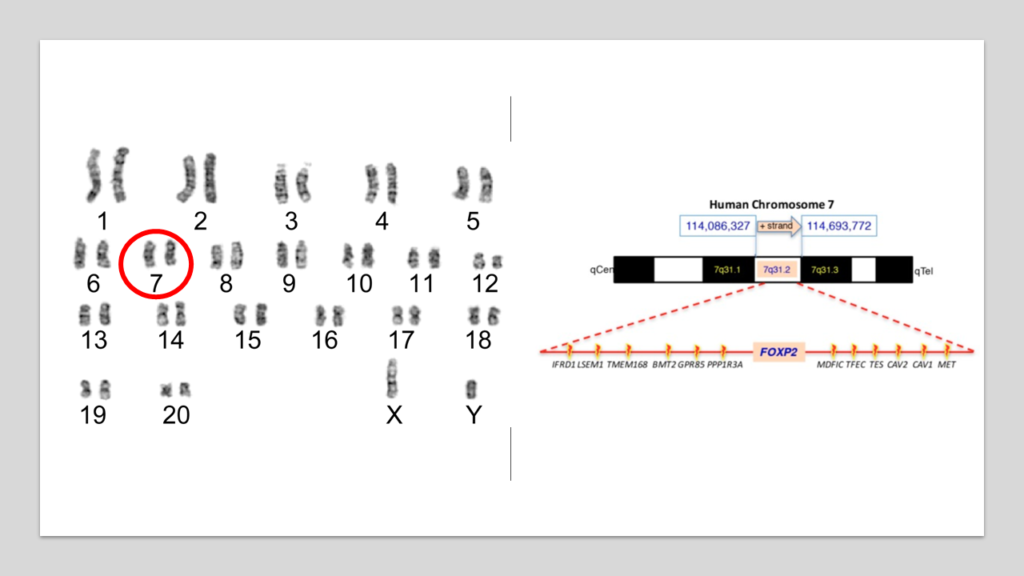From a young age, we are all exposed to language. Vocalization and communication are fundamental skills that quickly develop and keep developing as we grow, allowing us to interact with the world around us. We communicate with each other using different techniques that range from written to spoken language. But speech remains at the forefront form of this communication.
Have you ever wondered about evolutionary mechanisms that allowed us to develop and perfect this complex form of verbal communication? What is the genetic basis of speech in humans?
A lot of research has been done on this subject. And is still going on. A large array of genes have been identified as critical in this evolution of speech in humans. One such gene is FOXP2, and has been at the forefront of research on the evolution of speech in humans.
I had heard about FOXP2, but never really had an opportunity to explore in depth until recently. It was Martin Kot- my Argentinian friend and colleague from Takeda who made me curious about FOXP2 and inspired me to write this article. So, in this article, I will attempt to explore the incredible story of FOXP2 and its impact on the evolution of speech in humans.
What is FOXP2? FOXP2 is a gene. It is located on the short arm of chromosome 7 in humans. It is also found in other mammals such as mice and chimpanzees, but the location can vary slightly in different species. Chromosome 7 is a very important chromosome from from evolutionary standpoint. Apart from FOXP2, Chromosome 7 houses several important genes that are involved in neural development, synaptic plasticity, and cognition. Another gene called CNTNAP2, also located in Chromosome 7, is thought to influence the formation and functioning of neural networks in the brain, which are critical for language and social cognition. Mutations in CNTNAP2 gene is associated with language impairment, as well as conditions like autism and schizophrenia.
But, let’s focus- the protagonist of this article is FOXP2!

The FOXP2 gene encodes a protein called Forkhead Box P2. Forkhead Box P2 is a transcription factor. A transcription factor is a protein that regulates gene expression. The binding of a transcription factor to a promoter region of a gene can either activate or suppress the transcription of that gene. Transcription factors are important for the regulation of gene expression during development, in response to environmental stimuli, and in maintaining normal cellular functions.
FOXP2 protein plays a critical role in the development and functioning of various regions of the brain, including those involved in language. Mutations in the FOXP2 gene can lead to speech and language deficits in humans. FOXP2 gene is present in many animal species, from birds to rodents, suggesting its role in evolution of communication and language.
The first clues towards role of FOXP2 in evolution of speech in humans came to light when scientists decided to evaluate and study a British family with severe speech and language disorders. Members of this family had difficulty with speech, grammar, and language comprehension. In 2001, researchers discovered that these family members had a mutation in their FOXP2 gene and concluded that this mutation in FOXP2 is responsible for their speech and language deficits. It was this landmark discovery that made researchers turn their attention to studying FOXP2’s role in speech and language development.
FOXP2 is expressed in different areas of the brain, including the basal ganglia and cortex, which are essential for speech production, language comprehension, and motor coordination. Communication via speech involves motor co-ordination of laryngeal and oral muscles with flow of thoughts, and this orchestra is further layered with hand and facial expressions. Studies show that FOXP2 plays a significant role in brain development, enabling motor control, and learning new actions through imitation.

In 2002, researchers discovered that FOXP2 was present not only in human beings, but also in other animals. It is not only present in various animals and birds, the structure of the gene remains remarkably same across all species. This was confirmed in 2005 when researchers analyzed the FOXP2 gene sequence in various species. FOXP2 is indeed an extremely conserved gene in many different species, from mice to birds, and this suggests that it is an essential gene necessary for development of communication.
Although FOXP2 has been conserved for over 300 million years across various species, it did undergo two specific genetic changes in humans. These two changes represent a leap in evolution that resulted in unique protein structures that differ from other species. The protein changes brought by this evolution of FOXP2 in humans contributed to changes in the neural processing of speech and language that resulted the way we- humans- communicate through speech and expressions. No other animals or birds have achieved this ease and excellence in speech that we have. Thus FOXP2 seems to be one to driving forces that led to evolution of communication and speech progressively from animals to humans.
I hope you will agree that FOXP2’s evolutionary tale provides exciting insights into the development of speech in humans. It is really an amazing genetic miracle that with just 2 new mutations FOXP2 seems to have propelled human communication to level that cannot be matched by living organism in the biological world. And FOXP2 is just one of many such genes that made us Masters of Evolution! I have written extensively on how we humans came to master the game of evolution. Please read my articles on this topic HERE.
References:






I loved your blog post. Keep writing.
Its like you read my mind! You appear to know a lot about this, like you wrote the book in it or something. I think that you could do with some pics to drive the message home a little bit, but instead of that, this is fantastic blog. An excellent read. I will certainly be back.
Wow wonderful blog layout How long have you been blogging for you make blogging look easy The overall look of your site is great as well as the content
Thank you for the auspicious writeup It in fact was a amusement account it Look advanced to far added agreeable from you However how can we communicate
I loved even more than you will get done right here. The overall look is nice, and the writing is stylish, but there’s something off about the way you write that makes me think that you should be careful what you say next. I will definitely be back again and again if you protect this hike.